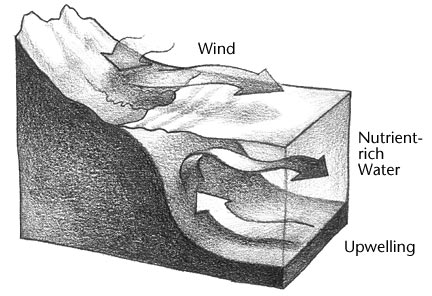![[Ocean Oasis - Teacher's Guide]](images/bnr-oo-tg.gif) |
 |
![[Ocean Oasis - Teacher's Guide]](images/bnr-oo-tg.gif) |
 |
|
|
![[Upwelling]](images/upwelling.gif)
What happens to cool, deep water when the warm surface water is moved away? |
|
In the Film |
Winds near the peninsula push warm water away from the surface allowing deep, cool, nutrient-rich water to rise, bringing nourishment to plankton, the basis of the oceanic food web. This process of upwelling is essential to the ocean oasis. |
|
Concept |
Wind patterns and currents may cause cold water to rise from deeper areas. |
|
Objectives |
To demonstrate the process of upwelling |
|
Content |
Science, language arts |
|
Background |
Dense, cold water is normally found deep in the ocean. Remains of dead, decomposing organisms sink to the ocean bottom making these deep, cold waters rich in nutrients. However, it is in the upper, sunlit layers of the ocean that phytoplankton (very small drifting plants) are able to utilize these nutrients with energy from the sun, and thus create a basis for oceanic food webs. The process of upwelling brings nutrients nearer to the surface. Upwelling occurs near some continental areas when offshore winds move surface water away from the shoreline, allowing cooler water to rise or upwell. Where upwelling occurs, marine life is rich. |

Periodically, the winds that move surface water away from the shore cease to blow. Upwelling fails, and the marine food web is disrupted. In addition, warmer surface water creates clouds, leading to increased rainfall over the land. This phenomenon, known as El Niño, creates situations of global consequence for many life forms. |
|
|
On the Web |
Earth and Sun: The Forces that Create an Ocean Oasis, discusses how winds and oceanic currents generate great productivity in the seas around Baja California, but are also the major cause of the aridity of the land. Photographs hint at the striking diversity of life that is a result of these forces. |
![[Materials]](images/materials.gif)
Per group of 2-4 students: 2 transparent pans at least 5" x 9" x 2" deep, food color, ice, water, medicine dropper, water pitcher, small container, flexible plastic drinking straws for each student. |
![[Procedure]](images/procedure.gif)
(teams, small groups)
|
|
|
|
Local Connection
Key Words |
|
Continue to Activity 7: Cool it: an animal adaptation |
Teacher's Guide Contents
Field Guide | Site Index |
Ocean Oasis: The Film
|
|
© 2000 San Diego Natural History Museum |